February 5, 2021
Air Date: February 5, 2021
FULL SHOW
SEGMENTS
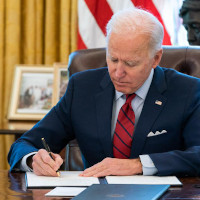
Biden’s Pen and the Climate
View the page for this story
President Biden has signed more executive orders in his first weeks than any president since Franklin Roosevelt in the 1930s, and many of those orders focus on protecting the environment and fighting against climate change. Jody Freeman, professor at Harvard Law School and former Counselor for Energy and Climate Change in the Obama White House, joins Host Bobby Bascomb to dive deeper into how these actions lay the groundwork for strong climate policy and green investment. (07:50)

Beyond the Headlines
/ Peter DykstraView the page for this story
In this week’s Beyond the Headlines segment, Environmental Health News Editor Peter Dykstra and Host Jenni Doering cover a new study that suggests some baby lobsters are adapting to ocean warming and acidification. Next, they discuss the life and legacy of the late Paul Crutzen, Dutch atmospheric chemist and Nobel laureate known for his work on the polar ozone holes and coining the term “the Anthropocene”. Finally, they reflect on the first mention of climate change in a State of the Union address, by President Bill Clinton in 1997. (04:45)

GM in the EV Fast Lane
View the page for this story
General Motors recently announced a bold plan to phase out gasoline-powered cars and light trucks by 2035. This move signals a major step towards decarbonizing the economy and creating thousands of green jobs and goes hand in hand with moves by the Biden Administration to incentivize EVs. Fred Krupp, president of the Environmental Defense Fund, joins Host Bobby Bascomb to discuss why GM is going all-in on an all-electric future. (09:05)

The COVID Biking Boom
View the page for this story
In early 2020, the US experienced a biking boom as people turned to cycling for safe mobility during the warmer months of the COVID-19 pandemic. But the biking craze has since lost some steam in parts of the US. Martin Morzynski, the VP of Marketing for Streetlight Data, joined Host Jenni Doering to talk about their report, Autumn COVID Bicycling Trends, and why some cities were able to hang on to their biking gains. (04:07)

An Owl-Inspired Hearing Test
/ Jess BurnsView the page for this story
Newborn babies are given hearing tests shortly after they are born, to ensure they can hear properly and develop language skills. But it’s tricky to do, as babies can’t speak to tell doctors what they are hearing. Now researchers at the University of Oregon may have found a solution, inspired by owls! Reporter Jess Burns with Oregon Public Broadcasting has more. (04:23)
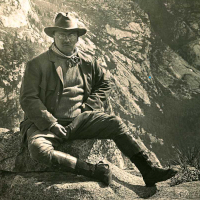
Teddy Roosevelt’s Conservation Legacy
View the page for this story
President Theodore Roosevelt’s famous rallying cry to “Leave it as it is” upon seeing the Grand Canyon for the first time continues to inspire conservation today. But his racism casts a shadow over his legacy in a time when conservation is being reimagined with more diversity and inclusivity. In his 2020 book Leave It As It Is: A Journey Through Theodore Roosevelt’s American Wilderness, author David Gessner reevaluates TR’s vision for today, and joins Host Jenni Doering to discuss. (17:02)
Show Credits and Funders
Show Transcript
210205 Transcript
HOSTS: Bobby Bascomb, Jenni Doering
GUESTS: Jody Freeman, David Gessner, Fred Krupp, Martin Morzynski
REPORTERS: Jess Burns, Peter Dykstra
[THEME]
DOERING: From PRX – this is Living On Earth.
[THEME]
DOERING: I’m Jenni Doering
BASCOMB: And I’m Bobby Bascomb
President Biden issues another round of executive orders aimed at climate change and appoints staff to implement them.
FREEMAN: The level of expertise that you see the administration putting in place in terms of the nominations that have been made, the appointments that have been made, even the acting officials that they've put in place temporarily to run the government, the clear message is hyper-competence.
DOERING: Also, GM announces plans to go all electric in light duty vehicles by 2035, a huge shift for auto manufacturing.
KRUPP: If we do this right, we can not only reduce climate pollution, clean the air for people make them healthier but we can also create jobs, jobs, jobs.
BASCOMB: That and more this week on Living on Earth – Stick Around!
[NEWSBREAK MUSIC: Boards Of Canada “Zoetrope” from “In A Beautiful Place Out In The Country” (Warp Records 2000)]
[THEME]
Biden’s Pen and the Climate
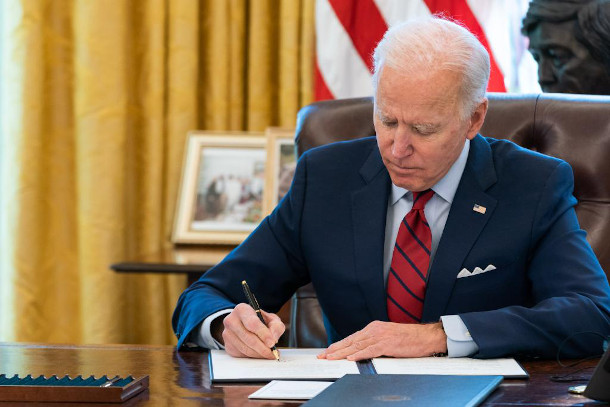
In his first days in office, Joe Biden signed a flurry of Executive Orders, including several to fight against climate change and protect the environment. (Photo: Official @POTUS Twitter)
DOERING: From PRX and the Jennifer and Ted Stanley studios at the University of Massachusetts Boston, this is Living on Earth. I’m Jenni Doering
BASCOMB: And I’m Bobby Bascomb
President Biden has signed more executive orders in his first weeks in office than any other president since Franklin Roosevelt back in the 1930s. And many of President Biden’s executive orders have focused on the environment and climate change. On his first day in office the president re-joined the Paris climate agreement, cancelled the Keystone XL pipeline, and directed federal agencies to review Trump era environmental policies. Now, he’s followed that up with several more executive orders. Jody Freeman is a professor at Harvard Law School and served as Counselor for Energy and Climate Change in the Obama White House. She says the latest round of executive orders puts in place a “whole of government approach” to embed climate change considerations in everything that the government does.
FREEMAN: So it put climate change front and center in national security considerations and put climate change front and center in terms of Department of Defense risk analysis, it put climate front and center in all the foreign policy ventures that the federal government participates in, like the major economies forum and the G 20.
BASCOMB: On the campaign trail President Biden pledged to stop new oil and gas leases on public lands and he made good on that promise with his second round of executive orders. But Jody Freeman says an executive order isn’t really a permanent solution.
FREEMAN: Making it permanent is a little bit tricky because the law is unclear about whether a president could just announce that there will be an absolute moratorium forever issuing any new oil and gas leases. Instead, what you see the administration doing is saying we're going to pause this, we're going to do a comprehensive review. And they'll conduct an environmental analysis, which will take some time. And the practical effect of that is that it will take a year or two or maybe even more, to figure out whether the environmental considerations in any new leasing program are being adequately considered. And so this is likely to look more permanent than temporary because of that. And there might be some leases that have already been issued, like the leases in Anwar, for example, the Arctic National Wildlife Refuge that the administration might try to pull back. So this would be an unusual situation because they've already been issued, but the argument there would be they were improperly granted, the environmental analysis with a climate change analysis was inadequate, and therefore they're reconsidering them.
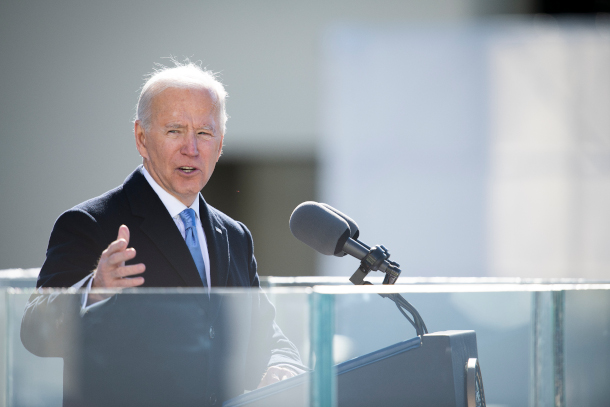
One of President Biden’s executive orders re-established PCAST, the President's Council of Advisors on Science and Technology. (Photo: Navy Petty Officer 1st Class Carlos M. Vazquez II, Chairman of the Joint Chiefs of Staff, Flickr, CC BY 2.0)
BASCOMB: Now one of President Biden's other executive actions was to reestablish PCAST, or the President's Council of Advisors on Science and Technology, which President Trump neglected to do during his first few years in office. What role do you think the council will have in the President's climate agenda?
FREEMAN: I think it's a very strong signal in the executive order that science is back, I think you see laced throughout both the first order I talked about, the second one that came later, is a real respect for science, wanting to make sure science is at the top of the agenda, because there was so much erosion of science and undermining of scientists in the Trump years. So what I think this signals, with PCAST being reconstituted, is that the President's gonna listen very carefully to the scientists and technologists, engineers and other experts so that policy will be informed by science rather than policy in spite of the science, which I think is what we saw in the Trump administration. And the level of expertise that you see the administration putting in place in terms of the nominations that have been made, the appointments that have been made, even the acting officials that have been put in place temporarily to run the government, the clear message is hyper-competence. These are people who either bring tremendous scientific expertise or knowledge of the field, or experience in government, and to a person, they know their way around. They know how policy ought to work, and they know how these agencies ought to work. And so it's very impressive what we're seeing put in place compared to what we have seen over the last four years.
BASCOMB: And what is President Biden planning in terms of helping people that are going to, you know, perhaps lose their jobs when we move towards a cleaner economy, you know, if they work in coal, or oil extraction, that sort of thing. And for that matter, environmental justice communities, which have been bearing the burden of environmental pollution for many, many decades here.
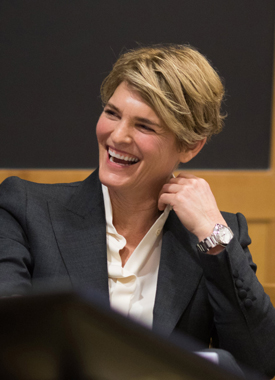
Jody Freeman is the Archibald Cox Professor of Law and the founding director of the Harvard Law School Environmental & Energy Law Program. (Photo: Harvard Law School)
FREEMAN: On the campaign, the Biden team made a really concerted effort to emphasize that they want to put in place an economic revitalization plan for the hardest hit communities, resource extraction communities that depend on fossil fuels so that they don't wind up on the losing end of an energy transition. And the Biden-Harris team pitched the clean energy transition as a transition with good union jobs. And that's really important to the economic agenda, which is actually included in the climate order. And that's why I think it's so noteworthy. It's a plan to start an inter-agency working group on coal and power plant communities economic revitalization. The other thing they're doing here very prominently is environmental justice. I mean, you see it all over these executive orders, you know, every agency is going to have an environmental justice officer, EPA is going to have an environmental justice Advisory Council, the Department of Justice, is embedding environmental justice in what it does. So what is this about? This is about taking into account that low income and minority communities have borne a disproportionate burden from environmental harms in the past, and try to make sure they do not continue to bear those burdens in the future. And there is a program in this executive order called Justice 40, which is an initiative to try to ensure that 40% of the benefits of all federal investments in this area go to disadvantaged communities. And I mentioned that because this is the first time we've seen environmental justice and a concern about resource extraction communities so prominent in a president's climate plan. I think it's really a special feature of the Biden-Harris team's vision. And it's really notable that it's made it into these plans.
BASCOMB: Well, as you you mentioned, Jody, there's a lot here. That's a very ambitious agenda that President Biden has set. But how do you think he can ensure that some of these executive orders aren't simply going to be reversed by the next person to take office? What are you looking for in the next four years here?
FREEMAN: What I'm looking for is a really robust effort by all the agencies to put programs in place, to put spending in place, to use their influence and their authorities, not just regulations, but every tool at their disposal. It is absolutely true that when you use your presidential power, when you use your executive branch agencies, a new administration can seek to reverse it. That's just the price of doing business. That's the cost of doing business. But the faster you can move, the further you can go, the more you can help steer private sector investments so that you have momentum. And you have some members of the private sector, some corporate leaders who are with you, and who want to see that continue, then you've got some traction that might actually hold in a future administration. What you're trying to do in the clean energy transition is get investments directed the right way. You want the next generation of power plants to be clean to be producing renewable energy, you want wind farms and solar farms, not coal-fired power plants. What you want to do with your presidential power is steer private sector investment. And that's what can be more permanent. And you can't ever inoculate an executive order from reversal. And you can't stop a rule from being reversed either. But what you can do is steer investments and get momentum embedded so that we're heading in the right direction of a clean energy transition, which becomes much harder to turn around if you get the private sector moving forward.
BASCOMB: Jody Freeman is a professor at Harvard Law School and served as Counselor for Energy and Climate Change in the Obama White House. Jody, thank you so much for taking the time with me today.
FREEMAN: My pleasure. Thanks for having me.
Related links:
- The New York Times | “Biden, Emphasizing Job Creation, Signs Sweeping Climate Actions”
- Click here for more on President Biden’s ‘Climate Day’ actions
- Read more on all of President Biden’s Executive Orders
[MUSIC: Tom Misch & Yussef Dayes, “I Did It For You” on What Kinda Music, by Tom Misch, Yussef Dayes, Beyond The Groove/Blue Note Records]
Beyond the Headlines
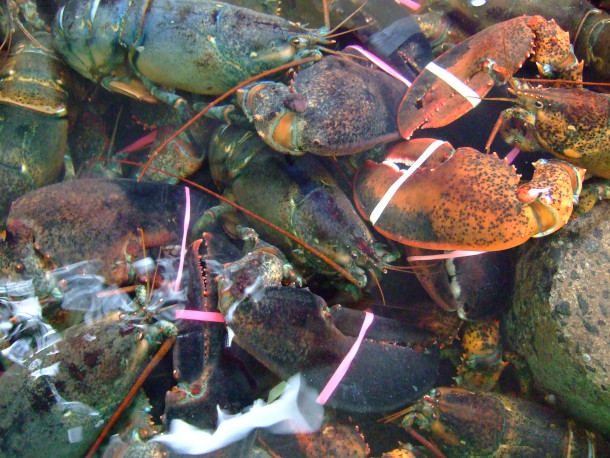
The American Lobster (Homarus americanus) is an iconic and economically important harvest in New England. A new study published in the Journal of Ecology and Evolution sheds light on possible adaptive genetic response of larval lobsters to climate change. (Photo: Ann Dabney, Flickr, CC BY-SA 3.0)
DOERING: Well, it's that time of the show when we call up Peter Dykstra. Peter is an editor with Environmental Health News. That's ehn.org and dailyclimate.org, and he's on the line from Atlanta, Georgia. Hey, Peter, what have you dug up from beyond the headlines this week?
DYKSTRA: Hi, Jenni. It's always good to start with a little good news. We don't always have a lot in the environment realm. Here's a study from New England, from the Gulf of Maine, just published in the journal Ecology and Evolution potentially offers some good news for lobsters in the era of climate change. Baby lobsters may be more adaptable to changes in both acidification and rising temperatures.
DOERING: Well, that's some great news to hear Peter because I thought that lobsters were really disappearing from even the Gulf of Maine.
DYKSTRA: Well, they've already partly disappeared from Long Island Sound to the south of the Gulf of Maine due to rising temperatures. Both rising temperatures and ocean acidification are threats to marine life, ocean acidification particularly a threat to shellfish. And this study examined post-larval lobsters and how they react to the effects of both. Results showed that the lobsters' genes responded to elevated acidification and possibly also to warmer waters. Results are, of course, preliminary, but if we have a species that can better cope with local effects, hopefully we'll continue to see lobsters on both Maine license plates and Maine dinner plates.
DOERING: I mean, my taste buds sure hope so Peter. Well, what else do you have for us this week?
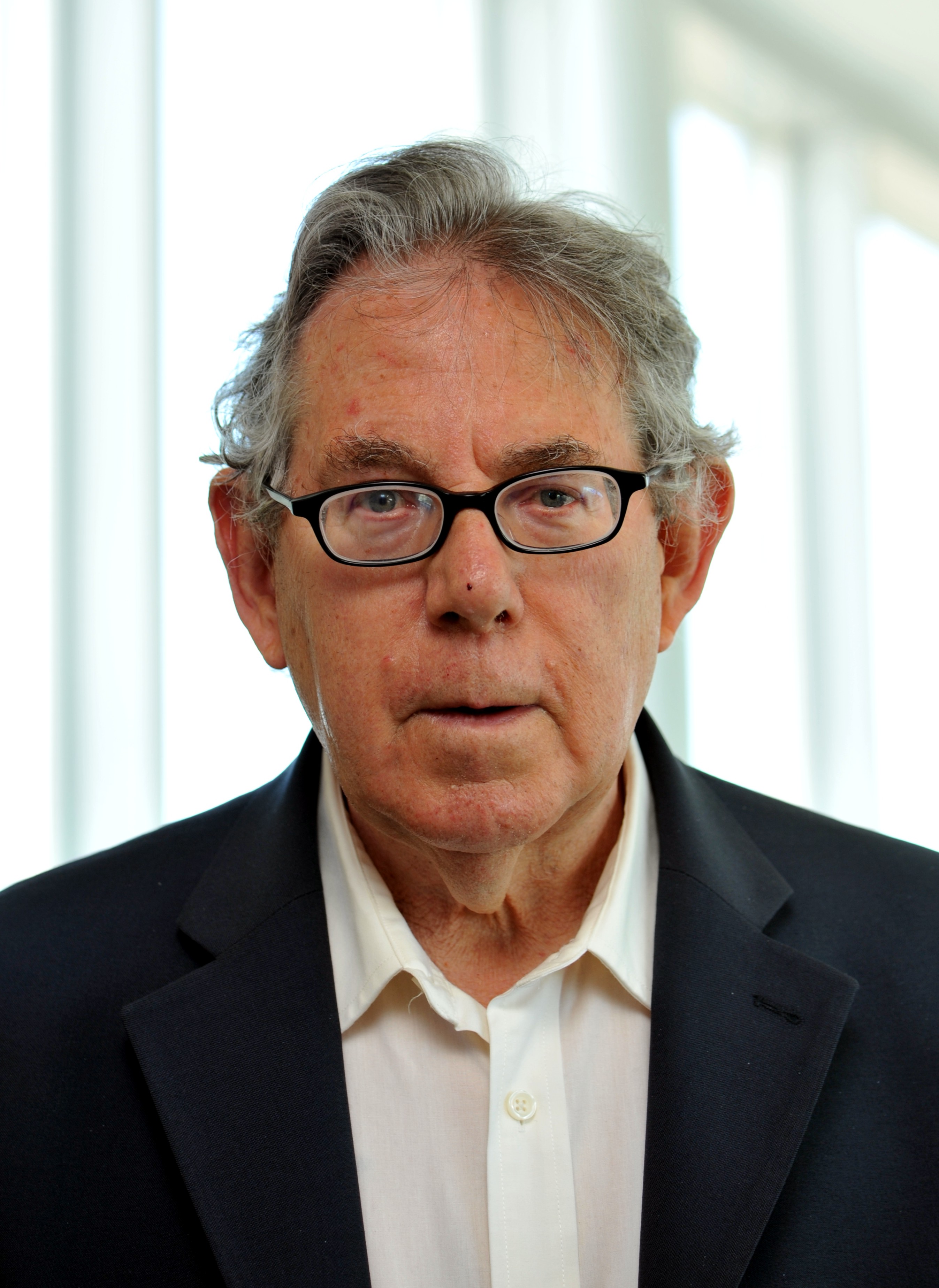
Paul Crutzen, the trailblazing atmospheric scientist and Nobel laureate, died on January 28, 2021. He coined the term the “Anthropocene”, widely used today to describe our current geologic epoch dominated by human influence. (Photo: Teemu Rajala, Wikimedia Commons, CC BY-SA 3.0)
DYKSTRA: Some sad news. This past week, the Dutch scientist Paul Crutzen passed away. He of course shared the 1995 Nobel Prize in Chemistry with Mario Molina. We talked about Dr. Molina when he died last year, and Sherwood Rowland who passed away in 2012.
DOERING: So these are those three big scientists who really did a lot of important work on the ozone layer. Is that right?
DYKSTRA: Arguably what Crutzen, Rowland and Molina did with some of the most valuable science to the environment world that we've seen to date. Science that also has yielded some hopefully positive results. They studied the stratospheric ozone layer, and the impacts that some industrial chemicals, particularly chlorofluorocarbons (CFCs), have had in creating the ozone holes at both the north and south poles.
DOERING: Oh, and by the way, Paul Crutzen, he's the scientist who actually coined this term that we use a lot now: the "Anthropocene". Is that right?
DYKSTRA: He did in work that he was involved in after his ozone hole work with Rowland and Molina. He coined the phrase Anthropocene meaning the geological era in which manmade impacts are changing the earth directly. There's actually a second name for this era, and that's the Plastocene era for all of the human introduced plastics we're finding in the environment.
DOERING: Well, Peter, Paul Crutzen had his place in history for sure. What else do you have for us from the history faults this week?
Ozone in the Antarctic, as shown by false-color images captured by NASA satellites.The blue and purple colors are where there is the least ozone, and the yellows and reds are where there is more. Since the Montreal Protocol banned emissions of ozone-depleting chemicals, the ozone layer has been slowly recovering. (Video: NASA.gov)
DYKSTRA: February 4th, 1997, in his State of the Union speech, President Bill Clinton became the first US president to mention climate change in a State of the Union speech and here's what he said:
CLINTON: We must also protect our global environment, working to ban the worst toxic chemicals and to reduce the greenhouse gases that challenge our health even as they change our climate.
DOERING: Wow Peter, that sounds like a pretty strong statement on climate all the way back in 1997.
In 1997, Bill Clinton became the first to mention climate change in a State of the Union Address. (Video: William J. Clinton Presidential Library, CC BY-SA 4.0)
DYKSTRA: 1997 and you would think, particularly with a vice president like Al Gore, that more could have been done. Politics, of course, got in the way. But 1997 wasn't the first presidential mention of any kind. You can go back a full generation to 1965. In a letter to Congress, President Lyndon Baines Johnson said, "This generation has altered the composition of the atmosphere on a global scale through radioactive materials, and a steady increase in carbon dioxide from the burning of fossil fuels". That was LBJ in 1965.
DOERING: Well, thank you, Peter. Peter Dykstra is an editor with Environmental Health News. That's ehn.org and dailyclimate.org. Thanks, Peter. We'll talk to you again next week.
DYKSTRA: Okay, Jenni, great. Talk to you soon.
DOERING: And there's more on these stories at the Living on Earth website. That's loe.org.
Related links:
- Bigelow Laboratory | “Research Illuminates Lobster’s Genetic Response to a Changing Climate”
- Washington Post | “Paul J. Crutzen, Nobel Laureate Who Studied Ozone And Named New ‘Anthropocene’ Era, Dies At 87”
- The Public Interest Network | “An Environmentalist’s Historical Guide To The State Of The Union”
[MUSIC: The B-52s, “Rock Lobster” on The B-52s, by Fred Schneider and Ricky Wilson, DB/Warner Bros]
BASCOMB: Coming up – Doubling down on biking to keep commuters safe amid the pandemic.
ANNOUNCER: Support for Living on Earth comes from Sailors for the Sea and Oceana. Helping boaters race clean, sail green and protect the seas they love. More information at sailors for the sea.org.
[CUTAWAY MUSIC: Johnny Burgin, “Samurai Harp Attack” on No Border Blues Japan, by Onishi/Nogio/Kotez, Delmark Records]
GM in the EV Fast Lane
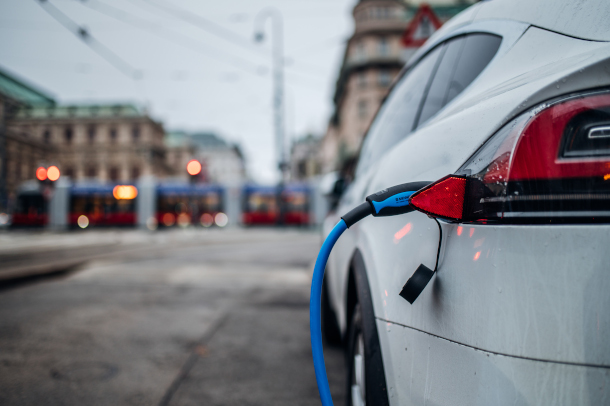
GM’s commitment to phase out internal combustion light duty vehicles by 2035 is one of the most ambitious in the auto industry (Photo: Ivan Radic, Flickr CC BY 2.0)
DOERING: It’s Living on Earth, I’m Jenni Doering
BASCOMB: And I’m Bobby Bascomb.
Before the break Jody Freeman told us that one of the best ways to bake in permanence with an executive order is to get buy in from industry. That way a subsequent administration would get push back from business interests if it tries to roll back policies that are working. General Motors recently announced an ambitious plan that would do exactly that. GM plans to phase out combustion engines in their light duty vehicles by 2035. And within just 3 years, by 2025, they pledged that 40 percent of their new models will be electric. That’s big news coming from the largest auto maker in the country. The plan does not yet include heavy duty box trucks and tractor trailers but their 27 billion dollar commitment to electric vehicles marks one of the most ambitious targets in the auto manufacturing industry. In the US transportation is the single largest contributor to carbon emissions so moving towards electric vehicles, powered by a clean energy grid that the Biden administration has promised, could make a huge dent in annual emissions. In the 90s General Motors famously killed the electric car, their EV1, But in 2016, 8 years after Tesla introduced its first electric car, GM came out with the popular Chevy Bolt, second only to Tesla in annual sales. GM worked with the Environmental Defense Fund to develop its electric vehicle plan. Fred Krupp, president of the EDF joins me to discuss why this is the right moment for GM to go all in on electric vehicles.
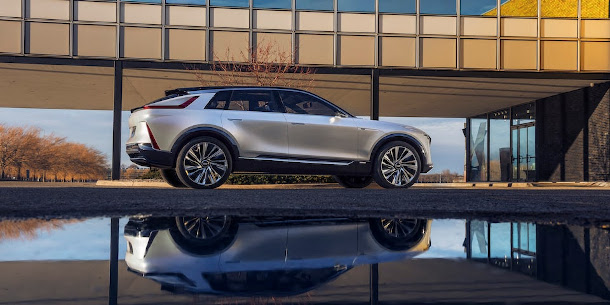
GM’s electric model for Cadillac called the Lyriq, which is scheduled to go on sale in 2022. (Photo: Courtesy of GM)
KRUPP: I think first of all, GM is a different company today than they were before they have a different leader and Mary Barra, the CEO, I think she's been making a lot of changes at GM over the years from, you know, selling Opel, their big European subsidiary that was founded in 1928, to this latest move of saying they're going all electric. So I think, you know, she is a very visionary leader, and someone who's got the courage to make big changes. The second thing that's changed though, is the world has changed. This is the future of autos, because they're just better products. They're faster to accelerate, they're more fun to drive all those people now are already buying electric cars. I wish I could tell you they're buying them to be environmentalists. No, they're behind them, because they're just great cars, less maintenance, less fuel costs. So I think GM understands this is the future. And the only question is, what are the companies who are going to prosper? And so often in business, the companies that see the way the future is going and what customers are going to want and make those changes earliest, are the companies that prosper.
BASCOMB: Now, of course, introducing an electric vehicle fleet that's charging up with electricity produced from oil and gas is, you know, somewhat pointless in terms of carbon emissions. Can you tell me though, about how this rollout might work in conjunction with plans from the Biden administration for renewable energy and EV charging stations?

This move by GM works alongside President Biden’s commitments to build more infrastructure for electric car charging (Photo: Ivan Radic, Flickr CC BY 2.0)
KRUPP: Well, you raise a really good point, Bobby, thank you for raising that. It's very important that as cars go electric that the grid becomes cleaner. And to their credit, GM has been outspoken proponent of moving the grid to zero carbon sources. And thankfully, the grid is moving that way. That needs to be accelerated. President Biden, in his campaign, had the boldest goal of any presidential candidate in our nation's history. He called for 100% clean energy by 2035. So I expect that the Biden administration will move that way, which is what is required as cars are becoming increasingly electric.
BASCOMB: Yeah, it's huge. I understand that President Biden also has a goal of half a million EV charging stations in the next 10 years and an all-electric fleet for the government. I mean, these seem to go hand in hand with what GM is planning.
KRUPP: Yes, it does. It's self-reinforcing. And it's important, the government will have to take steps to make sure that charging infrastructure is increasingly readily available, as we have more cars, we'll need more charging stations. And I expect that we'll see in the congressional legislation the Biden administration proposes in the next few weeks, we'll see money appropriated to help get those charging stations built. So that's important. But in addition, we need the government to adopt policies that under the Clean Air Act, require the automakers to clean the amount of nitrogen oxides and carbon dioxide, the greenhouse gas coming out of the tailpipes of these cars. And under the Clean Air Act, there is very clear authority for EPA, to speed this transition along. And when we do that, we will be saving lives because 1000s of people die every year because of the pollution that comes out of cars and trucks.
BASCOMB: And the Biden administration has made much of the fact that investing in renewable energy is a job creator. To what degree will this transition for GM create new jobs in electric vehicle manufacturing?
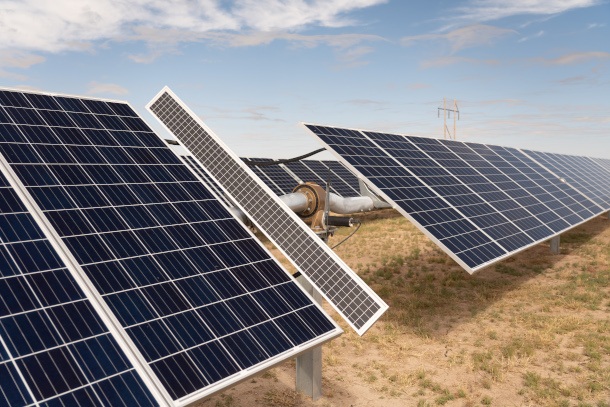
As the amount of renewable energy supplying the electric grid increases, electric cars make more of an impact on reducing overall emissions (Photo: Jonathan Cutrer, Flickr CC BY-NC 2.0)
KRUPP: Well, it'll create a tremendous amount of new jobs. You know, I might say that I've seen in some of the recent coverage of GM's move that Mary Barra is betting the company on this. I think the other way to think about it is she'd be risking the company if she didn't do this, because in many ways, it's a no brainer. Industry is going to go to the zero emitting technologies of the 21st century. And if GM isn't producing them, our country will be losing those jobs. So the real question here is how quickly does this transition occur, and which countries harvest the jobs that come with the transition? Right now, 95% of zero emitting vehicles are made in China. The US has to get better positioned and we now have GM saying they're going to invest $27 billion in electric vehicles. Industry wide, automakers will be spending more than $257 billion between 2030 developing new electric models. In the U.S., eight manufacturers have announced plans to spend $22 billion to open new or renovated plants. These are going to employ tens of thousands of people. So the U.S. has a lot to gain by having government policies that create the incentives to get our companies and our manufacturers into the business of making the cars that the whole world is moving to.
BASCOMB: And what kind of signal is this announcement sending to the market more broadly?
KRUPP: I think this is a signal that this is the future. When you see General Motors, you know, GM saying all our cars, we intend to be electric by 2035. And when you see GM saying they're investing $27 billion in this direction, this is not just a press release. This is a company that's turning around and changing direction, to move away from the internal combustion engine toward electrification. And that's really, really positive because combined with that cleaner grid, it means we can move from place to place in our comfortable cars without wrecking the atmosphere. And that's important for all of us and for our kids. And in my case, grandchildren.
BASCOMB: You sound very optimistic then looking forward.
KRUPP: I am very optimistic. First of all, President Biden is not, you know, night and day different than President Trump on environmental issues and climate. It's the difference between heaven and hell. Beyond that, you know, you have big companies making big announcements like the one GM has recently made. So I think things are moving in the right direction. It's going to still take action by Congress. It's going to take action by EPA to make sure we stay on the path and accelerate the path. But if we do this, right, we can not only reduce climate pollution, clean the air for people, make them healthier. But we can also create jobs, jobs, jobs.
BASCOMB: Fred Krupp is president of the Environmental Defense Fund. Fred, thank you so much for taking this time with me today.
KRUPP: Thanks for having me, Bobby. Much appreciated.
Related links:
- GM’s Official Press Release
- Fred Krupp’s Statement on GM’s Announcement
- Jody Freeman's NYTimes Op-Ed: "General Motors Is Counting On Your Loving Electric Cars"
[MUSIC: Widespread Panic, “Driving Song” on The Essential Widespread Panic, by Domingo Ortiz and David A. Schools, Sony Music Entertainment]
The COVID Biking Boom

During the peak of the coronavirus pandemic, between January and October of 2020, US bike sales went up a staggering 62%. (Photo: Thomas Hawke, Flickr, CC by NC 2.0)
DOERING: Bike ridership has gone up across much of the world since the pandemic began last year. People wanted to avoid gathering on crowded buses and subways, so they began to hop on bikes instead. Europe has spent over a billion dollars on biking infrastructure since last spring. And here in the US bike sales went up about 26 percent over the same time period. To see how the trend is going now, nearly a year later, we turn to Martin Morzynski, he’s the Vice President of Marketing for Streetlight Data. Martin joins us to talk about their recent report, Autumn COVID Bicycling Trends. Martin welcome Living on Earth!
MORZYNSKI: Thank you. Nice to be here.
DOERING: So what were some of the changes in bike ridership that you saw across the country during and after the COVID pandemic biking boom?
MORZYNSKI: So we saw a massive boost in riding really all across the country, particularly in March and April, when you saw the massive shutdowns across the country. People took up new habits and so forth, and all of that contributed to increased bike ridership. And, you know, we're all curious as to whether that would hold as people started to get back to sort of some sense of normalcy when it comes to getting around. And what I mean by that is, you know, if you look at vehicle miles traveled across the country, which is an indicator of street activity, that plummeted in April. And as the pandemic went on, there were different degrees to which states were locking down. And there were many places by May and June, where driving had come back, and biking stayed up. And you know, we sort of thought well, that's, that's a good indicator of change in habit. And there was some places like Des Moines, Iowa, where, you know, biking was up significantly in May and we thought, well, let's see what happens by the time we get to the fall and see if biking remains up.
DOERING: So what happened?
MORZYNSKI: ...And it did! So Des Moines was, you know, was up over 50% in May, and it was still up 50% year-over-year in September. But in places like Bakersfield, which is inland California, you know, where biking was up initially on this sort of boost and recreational activity, it was sort of back to normal by September, right. So the gains have melted away. So I think what we've observed is that it really depends on where you look across the country. And you know, when you look at large cities, for example, a lot of them plummeted in terms of bike ridership, because so much of their biking prior to the pandemic, was contributed to by commuting, right. And as commuting to downtown areas of cities like San Francisco, Boston and New York plummeted, you know, so did the total bike ridership in those cities.

Most federal funding for biking infrastructure comes from the Fixing America’s Surface Transportation Act. The FAST Act is set to expire on September 30, 2021. (Photo: Thomas Hawke, Flickr, CC by NC 2.0)
DOERING: So why do you think some cities were more successful at keeping these cycling rates up than others?
MORZYNSKI: Absolutely. So it's things like weather, for example, where, you know, we've seen a lot of communities across Florida maintain their gains. They also happen to be communities with good recreational infrastructure. But, you know, I think the other big factor is you saw a number of cities shut down car traffic to make streets safer for walking and biking. And we called out, you know, Denver and Oakland, California in the report as ones that have shut down a significant number of roadways. But in many cases, the same cities have also taken steps to build, not just temporary infrastructure, but permanent, safe infrastructure for biking. So whether it be separated bike lanes, or you know, changes in signals that allow for bikes to go through without cars going by at the same time, you know, cities that have taken those steps are seeing some of those gains, because you know, people feel safer to get back on the road, even as cars start to get back on the roadway. And ultimately, a lot of it comes down to safe infrastructure in the right place. It's hard to expect, you know, bike ridership to go up other than on the back of the fact that people have purchased bicycles and, and they'd like to continue to use them, right. But ultimately, if you bought a bicycle and you bought a bicycle for your children, and you don't think that, you know, you can ride them safely, you'll you know, you'll leave them in the garage. So we really do think that keeping these gains relies on both safe infrastructure and access.
DOERING: Martin Morzynski is VP of Marketing for Streetlight Data. Thank you so much for joining us, Martin.
MORZYNSKI: Thank you so much, really enjoyed the conversation.
Related links:
- StreetsBlogUSA | “The Biggest Covid 19 Bike Booms Weren’t Where You Think”
- Business Insider | “The US Wasn’t Equipped for the 2020s Cycling Boom. It’s Failures Stem from a Century of Leaving Bikes Behind”
[MUSIC: Jeremiah McLane, “Desoto” on Freetown, by Jeremiah McLane, Epact ]
An Owl-Inspired Hearing Test

Both humans and owls exhibit the same involuntary response: their pupils dilate when hearing a new sound. (Photo: Greg Clarke, Flickr, CC BY 2.0)
BASCOMB: Newborn babies are given hearing tests shortly after they’re born, it’s important to establish they can hear properly to develop language skills, But it’s tricky to do. Babies can’t tell doctors what they are hearing so it’s challenging to figure out how extensive hearing loss is in young children. Now it looks like researchers at the University of Oregon may have found a solution to the problem using… owls. Reporter Jess Burns with Oregon Public Radio has more.
BURNS: Our story starts about 20 years ago at the University of Oregon. Neuroscientist Avinash Bala was trying to measure how well barn owls hear as a way to better understand how human brains process sound.
BALA: We have the owl in a quiet room. We had a video camera like a security camera watching the owl.
BURNS: While they were setting up the experiment going in and out of the owls room. The odd door was slammed down the hall. Bala would drop something on a desk.
[DROPPING SOUND]
BALA: And I realized that every time something unexpected happened, the owls eyes seem to get brighter.
BURNS: They showed brighter on the video because the owls eyes were dilating in response to the new sound, reflecting more light back to the camera, like a cat in headlights. The experiment Bala was actually there to do wasn't working, says Institute of neuroscience co director Terry Takahashi.
TAKAHASHI: Avenashi was vextremely frustrated when he came up and said, Hey, this doesn't work. The only thing that happens when I play a song is the pupil dilates. And then all of a sudden, we all stop and go “aah wait a minute”.
[LAUGHS]
BURNS: They recognize this involuntary pupil response could be used to measure hearing in owls. And pretty soon thereafter, Bala figured out that humans have the same involuntary response to new sounds.
BALA: What I realized was that we could also use this in people who are unable to respond for one reason or another. And the biggest such group of people is infants. Because babies can tell us what they're thinking.
BURNS: There are hearing tests for young children out there and use. One measures the physical reaction of the inner ear to sound. One looks at the brainwaves of sleeping infants exposed to different noises. Still, another uses a little training and a sound like this.
[RINGING SOUND]
BURNS: To prompt the baby to look a certain direction when they hear a sound. But they all have different limitations says OHSU audiologist Kristy Knight.

Avinash Bala, a neuroscientist based in the University of Oregon, is working on facilitating hearing tests on infants. Detecting hearing loss within the first 6 months of a baby's life can help prevent further auditory and language development issues. (Photo: Marco Verch, Flickr, CC BY NC 2.0)
KNIGHT: One of the things that we really struggle with young children is knowing can they recognize the difference between sounds like else versus elf, for example. Our regular hearing tests don't tell us that
BURNS: Knight is working with Bala to test a new pupil response hearing test.
KNIGHT: This would give us another tool. Let's say a child is wearing a hearing device Are their hearing aids allowing them to discriminate the differences in speech sounds that are important for language development?
BALA: Yeah, hang on a sec, let’s do it again.
BURNS: At the baby hearing lab and Eugene, Bala asks grad student Jared Acosta King to help demonstrate the new test.
BALA: Okay, so now can you see the circle?
KING: Yes.
BURNS: Acosta King sits in front of the camera setup. Blue acoustic foam lines the walls of the sound booth. Bala shuts the door and starts the test from the next room over. Acosta King’s eye is blown up uncomfortably large on the monitor. The bah sound with the B plays every few seconds.
[Ba SOUND]
BALA: But each trial is coming up. The 10th one will be a different sound and we should pay attention to that because I'm expecting a really big dilation. So that's eight. This is nine. The next one will be a pah.
BURNS: That's pah with a P.
[Pah sound]
BALA: Ah there we go.
BURNS: Acosta King’s pupil grows noticeably in size.
BALA: It is so reliable, and it is so predictable. And that is what makes it so eminently usable.
BURNS: The version of the test designed for babies will keep their attention towards the camera with an animated video. A computer algorithm will be use to measure changes in pupil size as the different sounds are played. And if COVID-19 allows Bala says he hopes to start testing the new baby hearing test at Doernbecher Children's Hospital in Portland early next year. I'm Jess Burns reporting.
BASCOMB: Our story from Jess Burns comes to us courtesy of Oregon Public Broadcasting.
Related links:
- OPB | “Owl Research Leads Oregon Scientist to New Frontier in Baby Hearing Tests”
- EurekAlert! | “Oregon Researchers Test Hearing by Looking at Dilation of People's Eyes”
[MUSIC: Biff Smith, “If It’s You” on Solo Piano, by Biff Smith, self-published]
DOERING: Coming up – We’ll take a look at the lessons we can learn today from the conservation work of President Theodore Roosevelt. That’s just ahead on Living on Earth.
ANNOUNCER: Funding for Living on Earth comes from you, our listeners, and United Technologies, combining passion for science with engineering to create solutions designed for sustainability in aerospace, building industries, and food refrigeration.
[CUTAWAY MUSIC: Jeremiah McLane, “Desoto” on Freetown, by Jeremiah McLane, Epact]
Teddy Roosevelt’s Conservation Legacy
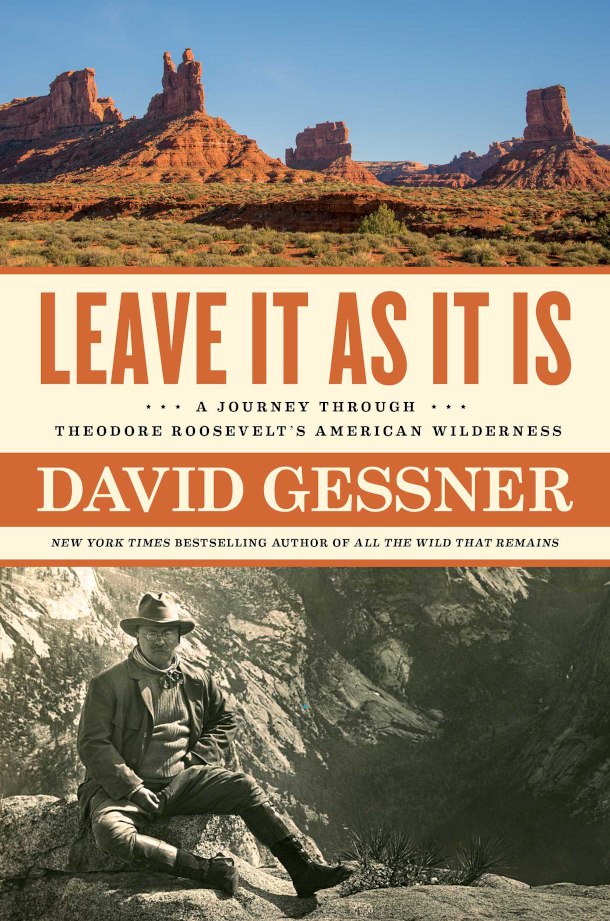
The cover of Leave It As It Is: A Journey Through Theodore Roosevelt’s American Wilderness. (Image: Courtesy of Simon & Schuster)
BASCOMB: It’s Living on Earth I’m Bobby Bascomb
DOERING: And I’m Jenni Doering
In 1903 President Theodore Roosevelt shouted through the wind as he stood at the rim of the Grand Canyon and delivered a famous rallying cry for conservation. “Leave it as it is,” he said. “The ages have been at work on it, and man can only mar it”. TR acted on those words and preserved over 230 million acres of public land using the Antiquities Act. But President Roosevelt was a flawed man. He was racist and a known eugenicist who viewed white Americans as superior, and believed Native Americans had no rightful place on their lands. Despite Roosevelt’s deeply troubling views on race, he still has a lot to offer us in a time of renewed calls for conservation, says writer David Gessner. He’s the author of Leave It As It Is: A Journey Through Theodore Roosevelt’s American Wilderness and he joins me now. Welcome back to Living on Earth, David!
GESSNER: Thank you. It's great to be back.
DOERING: So what exactly did Roosevelt do for conservation, David?
GESSNER: Well in a way he created it. I mean, he created the idea of it, he created the arena in which it was fought. Certainly there had been land saved and parks saved before him. But the fervor with which he took it on, I mean, he made it one of his top three goals of his administration. We never had that before or since with a President. And what you have, you know, in the end, he saved 230 million acres of public land. And he did it in a variety of ways. But perhaps the one most linked to him is the Antiquities Act, is the act through which presidents can save national monuments. It's a misconception that Roosevelt created that act, he did not. But Congress created it in 1906, and Roosevelt went right to work. Many of the traditions of that act started with him, including proclaiming monuments on your way out of office, which he did, and proclaiming larger and larger monuments, notably the Grand Canyon, where he said, "Leave it as it is," where he proclaimed 800,000 acres.
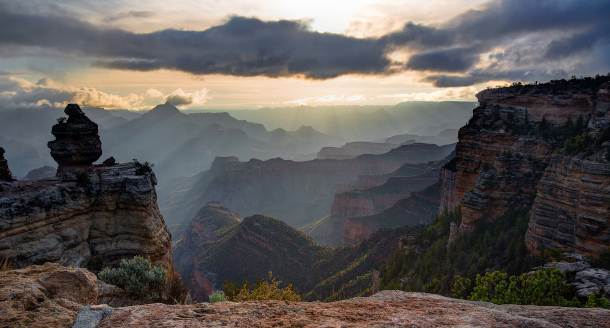
The Grand Canyon, where President Theodore Roosevelt declared “Leave it as it is” in a famous speech. TR designated Grand Canyon National Monument in 1908 and President Woodrow Wilson signed it into law as a National Park in 1919. (Photo: Scott Taylor, Flickr CC BY-ND 2.0)
DOERING: So David, why study Teddy Roosevelt? What do we gain from looking back through time at a man who seems almost mythical today?
GESSNER: I was thinking, hey, I've written ten books about the natural world. Maybe it's time for me to start fighting for the natural world, maybe it's time to put up or shut up, basically. And I thought, this is a pretty good character, for all his flaws, for all his contradictions, is a pretty good character to use as a role model, if I'm going to start getting in some battles.
DOERING: What kinds of battles were you hoping to get into?
GESSNER: When I moved out to Colorado when I was 30, I spent a lot of time traveling over to Southeast Utah, and I really fell in love with the Anasazi ruins and red and orange rocks. And, you know, I was just recovering from testicular cancer. And there was something tied to my recovery there, something, a feeling of excitement and health and all. And so I started to write about it. And many years later, in Obama's final term, in 2016, I was asked to write about that landscape in an anthology that was being used to support the idea of Bears Ears National Monument, and that anthology was given to all members of Congress, in the attempt to get this through. And in December of 2016, when Obama declared Bears Ears a National Monument, it was this great empowering and personal feeling, the personal tied to the political, that was so exciting for me. And then nine months later, when Donald Trump was president and Ryan Zinke was the Secretary of Interior. And he declared, in front of a portrait of Teddy Roosevelt, on Teddy Roosevelt's birthday, and claiming he was a Teddy Roosevelt Republican, that he would un-declare 85% of Bears Ears National Monument, the feeling was a little bit like, you know, being lifted high and slammed to the ground. And it was on that day really, that the book was born. And that day, I kind of decided that I was going to fight for that place and write about that place. And since Roosevelt was so linked to the story, I would use him as kind of my guide and model.
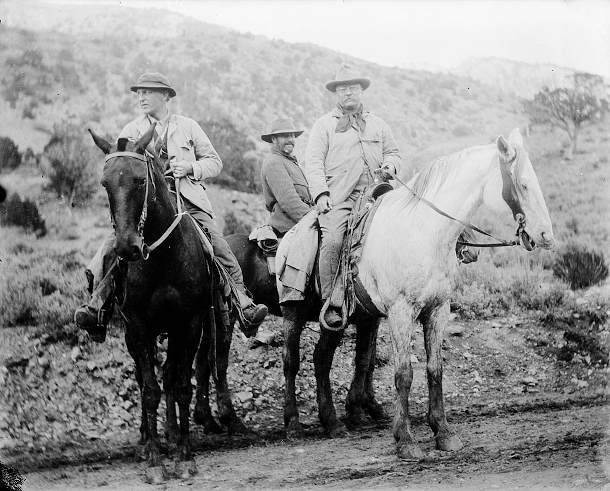
Theodore Roosevelt (front right) on an outing in Colorado, c. 1905 (Photo: Harry H. Buckwalter, Wikimedia Commons public domain)
DOERING: So of course, much of this book centers around Teddy Roosevelt's relationship with the lands and people of the American West, where most of the public lands in this country are, and the journeys that he undertook there. What was it about the West that really captured the imagination of TR and so many others?
GESSNER: Well, I think it's, you know, it's almost a cliche of the American going from East to West, and I lived it out, as I mentioned, when I was 30. And it coincided with a return to health for me. And I don't think that's that unusual. Roosevelt had an incredibly tragic 24th year of his life, when, in one day, he lost his mother and his wife, and he retreated into himself. And then he retreated and left the East behind and moved to the Badlands. A lot of people think of that as an exhilarating, thrilling time. And it's been written about that way by Edmund Morris and other biographers. But it was also a kind of exorcism, right? He, he was trying to get rid of, of what he'd left behind, the ghosts that were haunting him. And being Teddy Roosevelt and being hyperkinetic, he did it by throwing himself into, you know, ranching, into hunting, into being out in the wilderness. And he really felt himself kind of remade. He later said he never would have been president, if it had not been for his time in the West. And you also have him, you know, he'd always loved the natural world, and he'd always loved nature, but you have him falling in love with big wilderness. And so, Roosevelt would come back and save those lands he loved.
DOERING: Mmm. And he also knew them intimately, I think; he knew about the wildlife that he found there. You know, he's mythologized as this macho hunter and you know, trophy hunter. That's the first thing that you see if you visit his old house in Sagamore Hill, I think is the grizzly, mounted heads of some of his safari kills. But this other side of him was Roosevelt the naturalist. Can you tell us a little bit about that and the knowledge that he had?

Comb Ridge, an 80-mile-long angled sandstone formation, is a key feature of the Bears Ears National Monument and home to ancient Native American ruins. (Photo: Bob Wick, BLM, Flickr CC BY 2.0)
GESSNER: Well, he really started out as kind of a geek. You know, he didn't dream when he was young of being a statesman or soldier. He dreamed of being a field naturalist, like his hero, Charles Darwin. And, you know, this is somebody whose life changed when he saw a seal being pulled up on a fishmonger's table in New York City, and started studying it, measuring it. And then his world breaks wide open when he's 14, and he gets a gift of glasses, which helps him see the world better. And a gun, which helps him kill things. And just like Audubon before him, as a birder he would shoot birds to study them. But he loved birds, he loved bird sound, he loved the birds' music, and it changed him completely. He started to write because of birds. And to me, that's really fascinating. I mean, there's the famous story of him rushing into a Cabinet meeting, and saying he had important news, and they all wonder what it is -- "Are we at war?" and he said, "I just saw a chestnut-sided warbler, and it's only February!" So to me, Roosevelt's important now, because he gives us a model of someone who believed in science, someone who believed in large landscapes and ecosystems, and someone who, despite his prejudices, escaped one of our most obvious prejudices of all, which is anthropocentrism, the belief that man is most important. Here was a guy who, in the Oval Office, who believed that worlds beyond the human world, worlds of animal fungi, lichen, trees, that they mattered. And to me to have somebody like that right now, who could articulate for us why the climate fight is so important, because remember, that was one of the great things Roosevelt did. He invented the environmental fight in many ways. He gave us a language to think about it, you know, for our children's children. And I believe he could do the same thing today in the climate fight. Very good at digesting large amounts of information, and then putting them in simple inspiring language. And I guess one thing I really wanted to try to do with this book was inspire people and get them out there to fight.
DOERING: So David, one memorable passage in your book Leave It As It Is details Roosevelt's meeting with the famous naturalist John Muir, where he abandons most of his entourage in San Francisco, to head into the mountains with Muir and a few guides and porters. Could you read some of that passage?
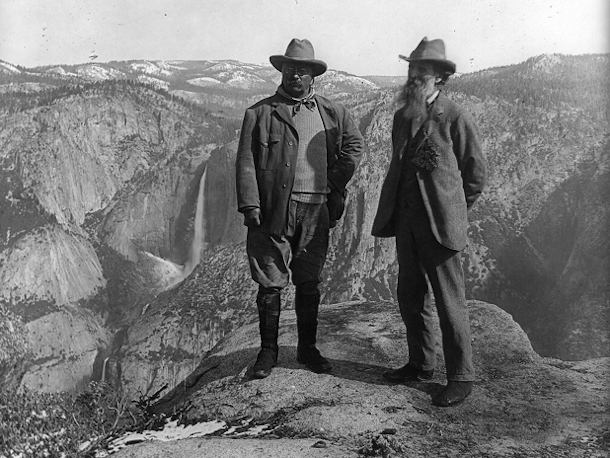
President Theodore Roosevelt, left, with naturalist John Muir at Glacier Point in Yosemite, 1906. (Photo: Underwood & Underwood, public domain)
GESSNER: Sitting around the fire, the two men talk. And talk. The president, by force of long habit, guides the conversation with polished monologues--his clipped sentences snapping off like the pine cones bursting in the fire--that sound as if they had been revised at his desk. He shoots words like rivets. The prophet is no less a pontificater, and also, through habit, used to having the floor. For both of them listening means waiting your turn to speak. Sometimes they can't wait and so barge right in. "Both men wanted to do the talking," one of the park rangers in attendance will remember. Their words clash against each other like waves around a point.
DOERING: So David, what did John Muir mean for Teddy Roosevelt and the environmental movement that followed?
GESSNER: You know, Roosevelt, I always think of him as kind of in between Muir on the kind of more left side, and Gifford Pinchot, his Forest Reserve director, on the other side. And Muir spoke, you know, in this kind of, as I say, religious, awe-filled language that I think Roosevelt started to adopt more and more. In that chapter that that passages from, I suddenly appear and pop into their world as they sit around the fire. This is a famous camping trip they took in the middle of his presidency, and they deserted all the press and the fancy folk who were having a big fundraiser and hiked up into Yosemite. And they camped out in the open, five inches of snow fell on them one night, they hiked into a blizzard. And they sat talking around a crackling fire. So in my little fictional interlude, I come popping in and I tell them of, you know, where the world has gone. I tell them about climate change. And I also call them out on some of the things where, if we're going to give Roosevelt credit for being ahead of his time, on environmental issues and being prescient. We have to call him out when he was behind his time. And both men were chauvinistic and, and were also very lacking in their appreciation of the native people who'd lived on the land before. You know, it's a standard biographical move, to bring up a flaw, excuse somebody or move briskly on. And with some of these issues with Roosevelt, I just let them sit there and say, Look, this is a complex, messy, hypocritical, but brilliant and accomplished, and very important person. And I think we have to be more comfortable with sloppiness, and extend some historical empathy. At the same time, we got to call people on things. I mean, I want to take from their lives, something we can use now, in the age of the pandemic, in the age of climate change. So I say they give us kind of a rough draft of a wilderness vision. There are things that are wrong with it, and their lack of empathy toward native people is a huge problem with that vision. But there are things that are great about it, too. So I want to discard what I find abhorrent, and embrace what I love about it, and use it now.

Native American rock art at Cedar Mesa, part of the original Bears Ears monument designation. (Photo: Bob Wick, BLM, Flickr CC BY 2.0)
DOERING: Well, so what do you say to people who say, you know, those men, those white men, they had their time, they got to do a lot of talking while other people didn't get to do any of the talking. And you know, they, certainly they had their moment. Now let's forge a new path. And let's, let's listen to some new voices.
GESSNER: Well, I respond by saying, I partly agree with them. And I think that part of the interesting thing that happened in the course of the book was I wanted to learn about the Antiquities Act and about Roosevelt, and about the early environmental fight. But the book more and more focused on Bears Ears National Monument. And Bears Ears National Monument is the first national monument to be born from the thinking, the planning, and the hard work of five Native American tribes. And I interviewed Regina Lopez-Whiteskunk, who was one of the Mountain Ute tribe members for the Bears Ears Inter-Tribal Council. And she said to me right away, we didn't want to relive, you know, historical trauma, we didn't want to say, it's our land, give it back. We wanted to use the tools of the United States to do something new. So she and the group studied the Antiquities Act. And they used that to create Bears Ears National Monument. And some of the things they included and that are included in the proposal, are the use of medicinal plants, are the use of the land for ritual, are the importance of the Native heritage. This was a land, this wasn't just common ground, now, it was common ground thousands of years ago for tribes that would meet and trade. So the exciting thing for me early on, was to take this old fairly sturdy vision of the natural world. You know, we call, Wallace Stegner called America's parks, "America's best idea." And maybe they weren't the best idea, but it was a pretty good idea. And to take that pretty good idea, and turn it in a new way, that includes inclusiveness, diversity, and a way of looking at the land not as a tourist, not as a user of the land, but as someone who belongs to the land. And to me, that was thrilling. And that changed the whole direction of the book. And one of the things I started to study was the history of taking land from Native people. An example would be the very first national monument, which we know as Devil's Tower, but was known to the native people there as Bears Lodge, and it had been sacred ground. So we saved that as a national monument, but before that, for hundreds of years, it was already the sacred special land belonging to the native peoples.

Devils Tower or Bear Lodge Butte in Wyoming was the first U.S. national monument, established on September 24, 1906 by President Roosevelt. It is considered sacred by Northern Plains Indians. (Photo: Tim Lumley, Flickr CC BY-NC-ND 2.0)
DOERING: David, how does the movement to protect Bears Ears represent a new vision for conservation, do you think, in this country, and maybe beyond?
GESSNER: Well, one thing I love about the Bears Ears fight, is if you read the declaration of Bears Ears as a national monument, it reads like a bunch of nature writers got together. In fact, it was Indigenous people, and then politicians who got together. But you learn not just about the history of the place that's being saved. You learn about the phenology, you know, the phenomenon of the year, what grows when, what buds when, when the birds return. And by the time I finished reading the proclamation, I felt like, wow, these are people who get it, who get a different view of the world, not as selling and buying and power, but as a process that goes on cycling through the year and then through the years, and then through the centuries. And that place has such a deep history. I mean, the place is the embodiment of the Antiquities Act. The very first time I walked into that landscape, we hiked without seeing anyone for two miles. And all of a sudden, tucked into the sandstone ledge was a little village, and I always compare it to like a cliff swallow's dwelling, it was so organic to the place, you know, and it had been deserted for 600 years. And here we were looking up at it. And, to me, that's, you know, just such an exciting connection between the past and the present. To look back and to learn from what came before. And to, you know, to give the people that came before the credit they're due, while being critical of them where we should be.
DOERING: David Gessner is the author of Leave It As It Is: A Journey through Theodore Roosevelt's American Wilderness and teaches at the University of North Carolina at Wilmington. Thank you so much, David.
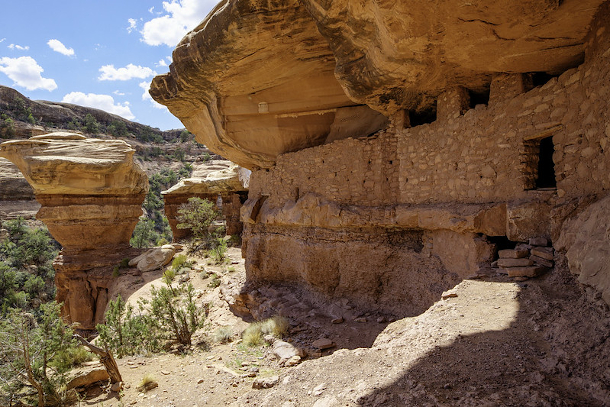
Moon House is one of numerous ancient cliff dwellings within Bears Ears National Monument (Photo: Bob Wick, BLM, Flickr CC BY 2.0)
GESSNER: Thank you, and I have to say as a way of goodbye, "Bully!"
DOERING: And there is “bully!” or “excellent” news for proponents of Bears Ears National Monument. On his first day in office, President Biden directed his Secretary of the Interior to consult with tribes and review the Trump Administration’s 85% reduction of Bears Ears.
Related links:
- Click here for the Leave It As It Is book (Affiliate link helps donate to LOE and local indie bookstores)
- Read the Bears Ears Proclamation
- About the Bears Ears Inter-Tribal Coalition
- About author David Gessner
- Listen to our previous interview with David Gessner on his book about classic nature writers Edward Abbey and Wallace Stegner
[MUSIC: Lawrence Blatt, “Orange Blossom Honey” on The Color Of Sunshine, by Lawrence Blatt, self-published]
DOERING: Living on Earth is produced by the World Media Foundation. Our crew includes Naomi Arenberg, Paloma Beltran, Grace Callahan, Jay Feinstein, Paige Greenfield, Leah Jablo, Mark Seth Lender, Don Lyman, Aynsley O’Neill, Jake Rego, Natalie Seo, and Jolanda Omari.
BASCOMB: Tom Tiger engineered our show. Alison Lirish Dean composed our themes. You can hear us anytime at L-O-E dot org, Apple Podcasts and Google Podcasts, and like us, please, on our Facebook page - Living on Earth. We tweet from @livingonearth. And find us on Instagram at livingonearthradio. Steve Curwood is our executive producer. I’m Bobby Bascomb
DOERING: And I’m Jenni Doering. Thanks for listening!
ANNOUNCER: Funding for Living on Earth comes from you, our listeners, and from the University of Massachusetts, Boston, in association with its School for the Environment, developing the next generation of environmental leaders. And from the Grantham Foundation for the protection of the environment, supporting strategic communications and collaboration in solving the world’s most pressing environmental problems.
ANNOUNCER 2: PRX.
Living on Earth wants to hear from you!
Living on Earth
62 Calef Highway, Suite 212
Lee, NH 03861
Telephone: 617-287-4121
E-mail: comments@loe.org
Newsletter [Click here]
Donate to Living on Earth!
Living on Earth is an independent media program and relies entirely on contributions from listeners and institutions supporting public service. Please donate now to preserve an independent environmental voice.
NewsletterLiving on Earth offers a weekly delivery of the show's rundown to your mailbox. Sign up for our newsletter today!
 Sailors For The Sea: Be the change you want to sea.
Sailors For The Sea: Be the change you want to sea.
 The Grantham Foundation for the Protection of the Environment: Committed to protecting and improving the health of the global environment.
The Grantham Foundation for the Protection of the Environment: Committed to protecting and improving the health of the global environment.
 Contribute to Living on Earth and receive, as our gift to you, an archival print of one of Mark Seth Lender's extraordinary wildlife photographs. Follow the link to see Mark's current collection of photographs.
Contribute to Living on Earth and receive, as our gift to you, an archival print of one of Mark Seth Lender's extraordinary wildlife photographs. Follow the link to see Mark's current collection of photographs.
 Buy a signed copy of Mark Seth Lender's book Smeagull the Seagull & support Living on Earth
Buy a signed copy of Mark Seth Lender's book Smeagull the Seagull & support Living on Earth

